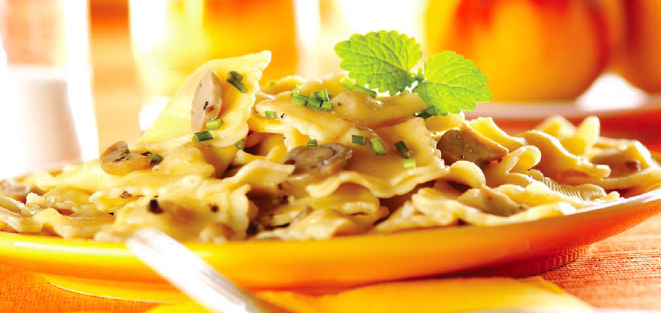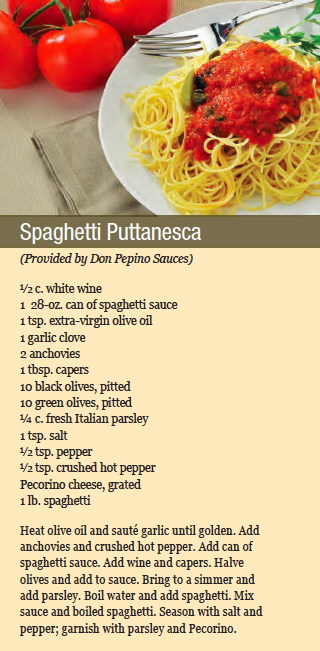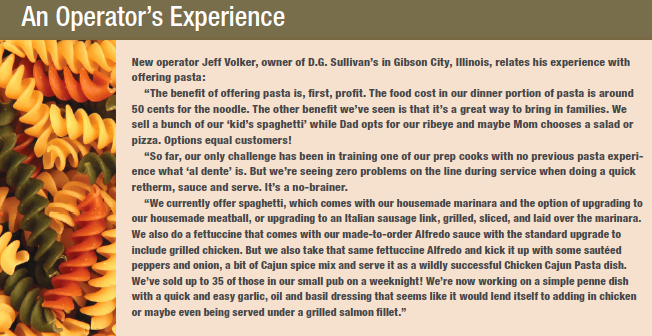
Is there any dish more comforting, simpler or more satisfying than pasta? Pasta, like pizza, is the type of food that many customers could eat every day due to the degree of customization that can take place. Just as you can apply virtually any topping to a pizza, you can incorporate endless varieties of sauce and other ingredients in pasta dishes. Pasta also has a variety of other benefits, including its impressive versatility. “One reason to sell pasta is that it is generally liked by everybody,” says Carla Squatrito, president of Carla’s Pasta in South Windsor, Connecticut. “The different colors and shapes can be presented and dressed with anything, and pasta makes a satisfying meal that isn’t expensive and doesn’t take long to prepare.”
Today’s customers crave variety and value, so even though you may already offer pasta on your menu, you should evaluate your combinations and your clientele. Are there ways you can better promote the dish? Can you spice up your pasta dishes with simple additions or changes? We spoke to several chefs and food experts to analyze how you may be able to take your everyday pasta dishes and move them faster than farfalle (that’s not only a pasta type—it means “butterflies” in Italian!).
The Basics
Pastas can be plain or filled, thick or thin, dried or fresh. Here is a sampling of pasta types, along with some suggested uses, courtesy of the National Pasta Association (NPA; illustrations and explanations of these and other styles can be found at ilovepasta.org):
Acini di pepe (“peppercorn”)—soup recipes, broths
Angel hair/capellini—tossed with thin, light sauce; stir-fry dishes; salads
Bucatini (hollow spaghetti-shaped strands)—casseroles, tossed with a variety of sauces
Campanelle (“bells”)—pasta salads; tossed with meat, cream, vegetable or oil-based sauces
Casarecce—tossed with meat sauce; casseroles
Gigli (“lilies”)—tossed with heavier sauces, such as cheese, meat or tomato
Orecchiette (“little ears”)—tossed with thick, chunky sauces; pasta salads
Penne rigate—tossed with chunky meat, chunky vegetable, cream or oil-based sauces; baked dishes
With so many pasta types, the choices can be overwhelming; what should you offer on your menu so that your business stands out from the crowd? You can start by thinking of sauce types and then pick the pastas that work well with the ones you choose. “I think a pizzeria should incorporate a tomato-based sauce, such as marinara or Bolognese; a cream-based sauce; broth-based sauces, to stay on the lighter side; and maybe a seafood- or chicken-inspired sauce, such as a sauce that incorporates clam juice,” opines chef Jeff Moogk, corporate chef and partner for La Jolla, California-based Sammy’s Woodfired Pizza, with 18 locations in California and Nevada. “Ultimately, what the owner wants will depend on the size and skill of the kitchen; he’ll need to understand the mechanics of putting it together, since pastas must be cooked to order.”
Pastas themselves can also add flavors to a dish—besides traditional white and whole-wheat options, owners can now choose from pastas in flavors such as squid ink, spinach, tomato and more. “It’s a good idea to rotate different things until you find what customers like; the more variety you offer, the better customers can choose based on their preferences,” suggests Squatrito, who notes that regional differences throughout the country often dictate customers’ tastes.
Moogk suggests that new menu items can be added at first as specials; then owners can see how the dish sells and is received by customers to determine if it would make a better long-term item; Sammy’s changes the menu at its locations four to six times per year to keep it fresh and keep customers interested. “We always post new items so customers are aware, and we offer discounts to come in and try them,” he says. “In specific neighborhoods, we might give a 20% off coupon to drive traffic midweek and get the new items in people’s minds.”
 Changing Tastes
Changing Tastes
Italian restaurants are known for their traditional pairings, such as manicotti with marinara or spaghetti Bolognese, but today’s diners are often more adventurous than their parents’ generation. Why not spice things up with a pairing that isn’t expected? Going global with your sauces is a great way to introduce unique flavors to the menu. For instance, Mexican-inspired flavors have been going strong for years now, and Asian influences are picking up speed. In fact, foodservice magazine Flavor & the Menu picked “chile-fired sauces” as its top sauce trend for 2010, pointing to customers’ expanding tastes.
“With the widespread influence of other cultures from travel, television (such as Food Network and the Travel Channel), as well as simply being a cultural melting pot, people have developed diverse and sophisticated palates, especially young people,” says Dennis Gavagan, director of research and development/corporate executive chef for Phillips Foods in Baltimore. “Sauces and condiments, along with technique, are truly the differentiators in all cooking; they allow you to be more things to more people with regards to flavor profile offerings.” Gavagan recommends that when introducing a new sauce, let customers taste them. “Sell ’em, don’t tell ’em!” he says. “Getting the flavor in someone’s mouth is truly the only way, and a one-bite offering when a guest sits down at the table will get you the sale if the product is on point.”
Besides allowing you to incorporate new and on-trend flavors, many sauces are also incredibly versatile. Squatrito notes that pesto sauce—a staple of Italian cooking—can be used in a multitude of ways: tossed with pasta; mixed with mayonnaise and used as an aioli for dipping or as a sandwich spread; and blended with yogurt for a light dressing. “Today’s tastes are more accepting of piquant flavors, and people are often willing to try new and trendy things,” she notes. “Many enjoy the traditional way, but trends modify traditions, which is a good thing.” Squatrito also notes that vegan options, including eggless pasta, and stuffed shells and tortellini with tofu-based fillings, have also become more popular, especially among elderly customers and college kids, who tend to be more health-conscious. Many operators have found success with accommodating a range of diets, including gluten-free; and chefs can also use less or no salt while cooking to offer a low-sodium option.
No matter what types of pasta and sauce you offer at your pizzeria, your focus will need to go on the product. “The quality and consistency is paramount,” emphasizes Moogk. “Use the best possible ingredients and stick to your guns, especially in these economic times. After all, people enjoy sharing these days, and pizza and pasta both encourage sharing!”















